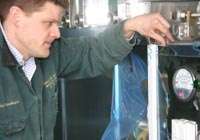Tasting maple syrup, for science

Forget about buckets. In recent years, maple syrup has been made with reverse osmosis sap extractors and air injectors. This week, the University of Vermont's Proctor Maple Research Center in Underhill Center, VT, has opened a new research building to test exactly what effect these new technologies have on the chemistry and flavor of syrup.
It is the only such research processing facility in the world.
"Nobody since the 1940s has done these kinds of experiments, and the industry has changed a lot since then," says the center's director, Tim Perkins.
UVM's new facility will conduct experiments on up to four evaporators simultaneously, fed by a common sap source, allowing researchers to discover whether anecdotes about new, faster equipment are supported by science. For example, "air injectors appear to make the syrup lighter," Perkins says, but "how do they impact the flavor?"
Maple syrup science is a nose -- and mouth -- science. The technical term is organoleptic. "Which means you put it in your mouth and taste it," says Perkins. "We get people who know the flavor of maple syrup, and off-flavors, and they try each one." Laboratory tests using gas chromatography provide a breakdown of the many compounds in the syrup, which supplements the tastebud approach.
The interplay of seasonal tree biology, boiling temperature, microorganisms, sugar chemistry, storage time, final container -- and a long list of other subtleties -- makes each glinting amber-to-chocolate bottle of syrup nearly as distinct as varieties of wine. "Syrup is not just concentrated sap," Perkins says.
This new facility will allow Perkins and other researchers to conduct experiments on up to four evaporators simultaneously. With funding from the USDA, his research over the next two years will focus on air injectors.
Maple research began at UVM in the 1890s and the Proctor Maple Research Center was established in 1946 with the donation of an old hill farm to UVM by Governor Mortimer Proctor. It's one of three maple research stations in the world, along with Cornell's and the Centre Acer in Quebec.
The new facility was built with funds from the Proctor Center's endowment fund, established by UVM in 1999, and contributions from individuals, maple-related companies, and several maple associations.
By providing objective data about the chemistry of maple syrup, Perkins expects this new research facility will help producers make sense of new tools in an old art.
Source: University of Vermont
















